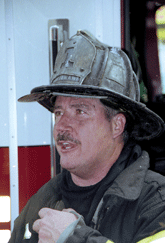On Sept. 11, 2001, Michael Pena was off duty, but not for long. After news spread of the attacks on the World Trade Center, Pena, one of three lieutenants with the Fire Department of New York City's Rescue Company 1 in Manhattan, an elite group on the order of the Navy Seals, reported to the scene just as the south tower collapsed.He formed a team with other firefighters to assist with the rescue of firefighters and civilians trapped in the north tower. During the course of the operation, he and his team had to improvise their way around the city's communications shortcomings.Most of the equipment used by on-duty personnel was lost, so his team gathered equipment from undamaged fire trucks and took communications gear, such as walkie-talkies, from colleagues being transported to area hospitals.'The only communication I had was within the fire department by radio,' he recalled. 'We had no communication with other agencies on scene, except face to face.'He has taken the lessons learned that day with him into the federal realm. Six months after the attacks, Pena, who served with FDNY for 21 years, retired from the department and joined the Federal Emergency Management Agency's Region 2 operations and planning branch. He was with FEMA for four years'through hurricanes Katrina and Rita'before taking his current job, as regional emergency coordinator for Region 2 (New Jersey, New York and the Caribbean) with the General Services Administration.His experience with communications issues at the local level has left him sounding frustrated. 'The main problem with communications in New York City is not the technology but rather the human factor of the police department and the fire department not wanting to communicate with each other,' he said.'It did change a little after 9/11, with the integration of radios placed in both police department and fire department supervisor cars to be able to communicate with each other on the command level. This is where the interagency communication needs to be, not on the operational level between firefighters and police officers.'Pena said that now, with the perspective of a federal responder, he can see that the push, shortly after the attacks, to establish communications interoperability between local and federal agencies was premature.'They weren't even interoperable at a local level,' he said. 'It's like trying to build a house starting with the roof. You have to start with walkie-talkie radios and make those interoperable, and then move up the technology chain.'But until recently, there wasn't much technology at FDNY, Pena said. 'Pre-9/11, we always joked that our lives were based on the lowest bid. But the last captain has been very proactive, even calling vendors to test products. Now, vendors go to them to have the department test products.'And yet, FDNY still does not have modern systems where it counts. Consider accountability for firefighters sent out to an event. Pena said that while some departments in the New York area use electronic identification tags that can be scanned when firefighters leave and return, FDNY still uses 'riding lists.'The officer of the company literally writes the names and positions of the firefighters on two, 3-by-5-inch sheets of paper, keeping one copy on his person and placing a second copy on the vehicle dashboard.'On 9/11, I located the Rescue 1 apparatus, but the front cab, where the riding list was kept, was buried under collapsed debris,' said Pena. 'Standard operating procedure for the FDNY is to take a roll call of all units on the scene directly after a collapse.'For this incident, there was no way to conduct a roll call because most of the company's vehicles were destroyed, or the company itself was gone.'Information sharing was the most frustrating component of the rescue operation, Pena said. 'Accountability was left to the company level supervisor, and immediate information on where each company was operating was nonexistent. Questions like what building were they operating in, what floor, or [whether] they were operating together were some of the questions we were not able to get direct answers for. It was all hearsay and conjecture.'The city has made improvements since 2001, though it hasn't solved all its communications problems.The day after the attacks, New York did adopt a Global Positioning System field data collection system. According to Pena, the fire department was in charge of documenting the items recovered from the rubble and recording the location, time, and type of item found to help investigators analyze what happened.Initially, firefighters were manually recording the information with a magic marker on paper to be input back at the command center.Pena said that LinksPoint Inc., a mobile information systems company based in Norwalk, Conn., set up FDNY with handheld devices to tag each item with a bar code, select a description of the item and, with a GPS attachment, automatically capture the time, date and location of its recovery. The data was fed into an application mapping the 16-acre disaster site to pinpoint where the item was recovered.If Pena was frustrated by his experience with communications at FDNY, he has used it to help fuel changes at GSA's operations in Region 2. 'I notify GSA employees during emergencies,' he said. 'We have remote sites in other states we can connect to from the New York area to broadcast information through a variety of technologies'land line, cell phone, Web sites, e-mail. We don't rely on just one service. Most cities have been doing this since 9/11. There's been a recognition that they need redundant systems.'Pena has three items he would like to see put in place for local first responders:Pena said backup or redundant systems such as self-powered radios, hard-wired communications, mobile communication systems and auxiliary power backups should be in place if needed.
FIRST CAREER: Pena spent 21 years with the fire department in New York City before joining FEMA and then GSA.
Courtesy of Michael Pena
- The ability to communicate with each other at the command level
- Communication with the local office of emergency management set up as the central point of resource requests, so that OEM can coordinate, prioritize and avoid duplication of efforts
- Communications starting with basic radio for local communications, along with cell phones, direct-connect phones and BlackBerry devices.







